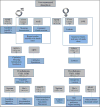Neuroanatomical dichotomy of sexual behaviors in rodents: a special emphasis on brain serotonin
- PMID: 26110223
- PMCID: PMC4777293
- DOI: 10.1097/FBP.0000000000000157
Neuroanatomical dichotomy of sexual behaviors in rodents: a special emphasis on brain serotonin
Abstract
Much of the social behavior in which rodents engage is related to reproduction, such as maintaining a breeding territory, seeking mates, mating, and caring for their young. Rodents belong to the internally fertilizing species that require sexual behavior for reproduction. The dyadic, heterosexual patterns of most mammalian species are sexually dimorphic, but they also share mutual components in both sexes: sexual attraction is reciprocal, sexual initiative is assumed, appetitive behavior is engaged in, and mating involves consummatory and postconsummatory phases in females as well as in males. Serotonin, a phylogenetically ancient molecule, is the most widely distributed neurotransmitter in the brain and its signaling pathways are essential for numerous functions including sexual behavior. Since the late 1960s, brain serotonergic neurotransmission has been considered to exert an inhibitory influence on the neural mechanisms mediating sexual behavior. This contention was based mainly on the observations that a decrease in central serotonergic activity facilitated the elicitation of sexual behavior, whereas an increase in central serotonergic activity attenuated it. However, the discovery of over 14 types of serotonin receptors has added numerous layers of complexity to the study of serotonin and sexual behavior. Evidence shows that, upon activation, certain receptor subtypes facilitate, whereas some others suppress, sexual behavior, as well as sexual arousal and motivation. Furthermore, the role of these receptors has been shown to be different in the male and female sexes. The use of serotonergic pharmacological interventions, mouse strains with genetic polymorphisms causing alterations in the levels of brain serotonin, and animal models with genetic manipulations of various serotonin effectors has helped delineate the fundamental role of this neurotransmitter in the regulation of sexual behavior. This review aims to examine the basics of the components of female and male sexual behavior and the participation of the serotonin system in the modulation of these behaviors, with emphasis on rodents.
Figures

References
-
- Ahlenius S, Larsson K. Specific involvement of central 5-HT1A receptors in the mediation of male rat ejaculatory behavior. Neurochem Res. 1997;22:1065–1070. - PubMed
-
- Albinsson A, et al. The effects of lesions in the mesencephalic raphe systems on male rat sexual behavior and locomotor activity. Behav Brain Res. 1996;80:57–63. - PubMed
-
- Alves SE, et al. Immunocytochemical localization of nuclear estrogen receptors and progestin receptors within the rat dorsal raphe nucleus. J Comp Neurol. 1998;391:322–334. - PubMed
-
- Amstislavskaya TG, Popova NK. The roles of different types of serotonin receptors in activation of the hypophyseal-testicular complex induced in mice by the presence of a female. Neurosci Behav Physiol. 2004;34:833–837. - PubMed
Publication types
MeSH terms
Substances
Grants and funding
LinkOut - more resources
Full Text Sources

